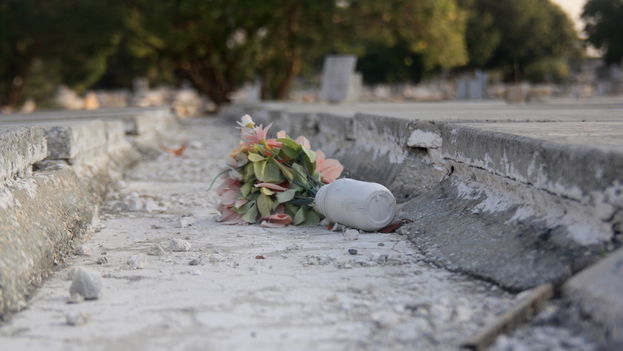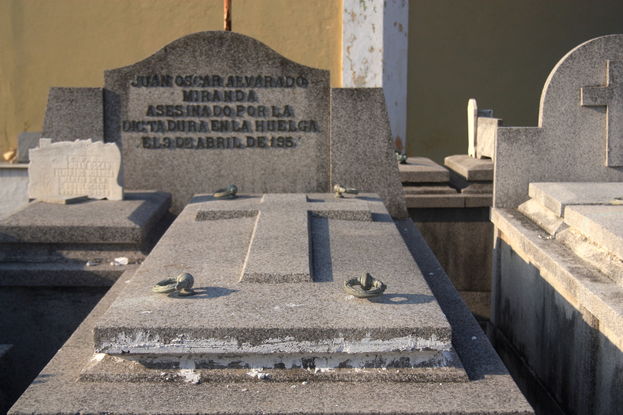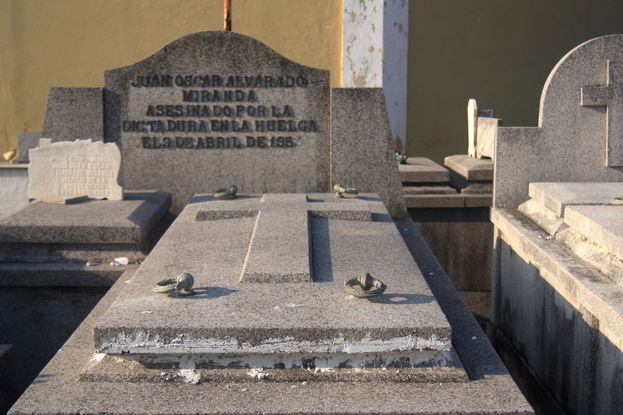
![]() 14ymedio, Zunilda Mata, Havana, 14 October 2017 — “In this street there are five vaults for sale,” says Boris Fernandez as he walks through Colón (Columbus) Cemetery in Havana. “That one has the granite stone but people with money prefer marble,” he explains. His business is “to guarantee rest in the afterlife,” this salesman who lives off the funeral business tells 14ymedio.
14ymedio, Zunilda Mata, Havana, 14 October 2017 — “In this street there are five vaults for sale,” says Boris Fernandez as he walks through Colón (Columbus) Cemetery in Havana. “That one has the granite stone but people with money prefer marble,” he explains. His business is “to guarantee rest in the afterlife,” this salesman who lives off the funeral business tells 14ymedio.
“The first time I sold a grave was almost by accident,” recalls the former engineer, now a real estate agent for the afterlife. “In 2011 I was contacted by a lady who wanted to get rid of everything to leave the country. The first thing I found for her was a buyer for the family vault,” he says.
The cremation of corpses is a strong competitor for the traditional burials managed by Fernandez. In 2013, 5,045 bodies were incinerated throughout the country. However, “there are still many people who prefer to spend eternity in a beautiful place like this tomb,” he explains as he points to a gravestone with bronze letters.
Over the years, the dealer has become a specialist in his services and each satisfied customer in turn recommends new customers. “I have learned to price tombs, vaults and ossuaries because there are many details to keep in mind.” He has studied “even a little art history” to determine styles and influences.
“This one here has rounded lines and the vault includes two art deco gardens,” he says, describing a tomb next to the central chapel of Cuba’s largest graveyard. “That is worth at least 5,000 CUC [Cuban convertible pesos, roughly the same in dollars] because it has Carrara marble, coming from Italy and is highly treasured for its whiteness.”
The sellers are mostly people who come from families of ancient ancestry who “are going through hell to survive economically and decide to get rid of the family vault,” or they might be “people who want to emigrate and need ‘to complete’ [get a certain amount of money] for the passage,” explains the funeral director.
The transfer process must be done before a notary, but the vast majority of those involved prefer to simply hand over the title deed even if it is still in the name of someone who died more than a hundred years ago. “Whoever has the papers is the owner, it’s as simple as that,” explains Fernández.
“These are exchanges often done in a rush, and all it takes is to deliver the documents for the new owner to take possession of the place,” he points out. “So far I have not had any clients who got into trouble and I have helped many people find a place for their dead.”
The cemetery authorities are aware that economic inequalities are emerging once again in one of the most luxurious cemeteries in Latin America. “There is a lot of business in sales but there are areas that are frozen because they belong to the heritage area,” explains one of the guides that runs the tours for tourists.

“We have more turnover in the tombs that are not the most striking and that belonged to families of the republican bourgeoisie,” he clarifies. “The main reason is economic, because very few people get rid of something like that because they do not have time to take care of it or they do not care anymore.”
“We have had cases of people who have sold the vault even with the deceased inside,” Fernandez notes with alarm, as he accompanies visitors on a tour of the most famous burials in the site.
This reality is confirmed by Abelardo, a resident of Columbus Street near the capital’s largest cemetery who dedicates himself to the business of selling tombstones, flower boxes and vases. “People have come for help selling a tomb but insist that the buyer must commit to leaving the remains that are in the ossuary,” he details.
“In that case a special price is set and the new owner gives his word not to remove the bones of the previous family, it is a gentlemen’s agreement,” he says.
In addition to the grave ornaments he sells in the doorway of his house, Abelardo has contacts for all kinds of tasks related to the deceased. “We offer natural and plastic flowers, demand for the the latter has greatly increased after the campaigns against the Aedes Aegypti mosquito [transmitter of dengue virus and other diseases] which has removed many vases with water from the cemetery.”
“I also have a friend who does the spiritual cleansing of the tomb so that the new owners can use it without bad influences,” he adds to his string of offers. “For Catholics he does with prayers, for the Santeros [practitioners of Santería] he has an offering that includes a cleansing with herbs, and if they are spiritualists then the ceremony can include candles and glasses with water.”
The increase in the sale of tombs is not a phenomenon that occurs only in the capital, but rather is widespread in the country’s cemeteries.

Niliana is selling a family vault of five square meters “in the best area of the Tomás Acea Cemetery in Cienfuegos,” she emphasizes. Because the cemetery is further away from the city, prices are lower, but still remain inaccessible to those who live off their official salaries.
For 560 CUC, the buyer can bury his relatives in a cemetery declared a “National Heritage site since 1978 for its artistic, architectural, historical and environmental values,” explains the owner.
At double that price a much more modest tomb is marketed in Colón Cemetery. “It is like with houses, the location determines the price,” clarifies Boris Fernandez. “The one with the best economic situation can choose a good street or be next to a famous vault.”
“Now I have a client who is a painter who wants a tomb with a tree that gives him shade and as close as possible to the Chapel,” he says. “My job is to please him: I bring the place and he brings the dead.”
